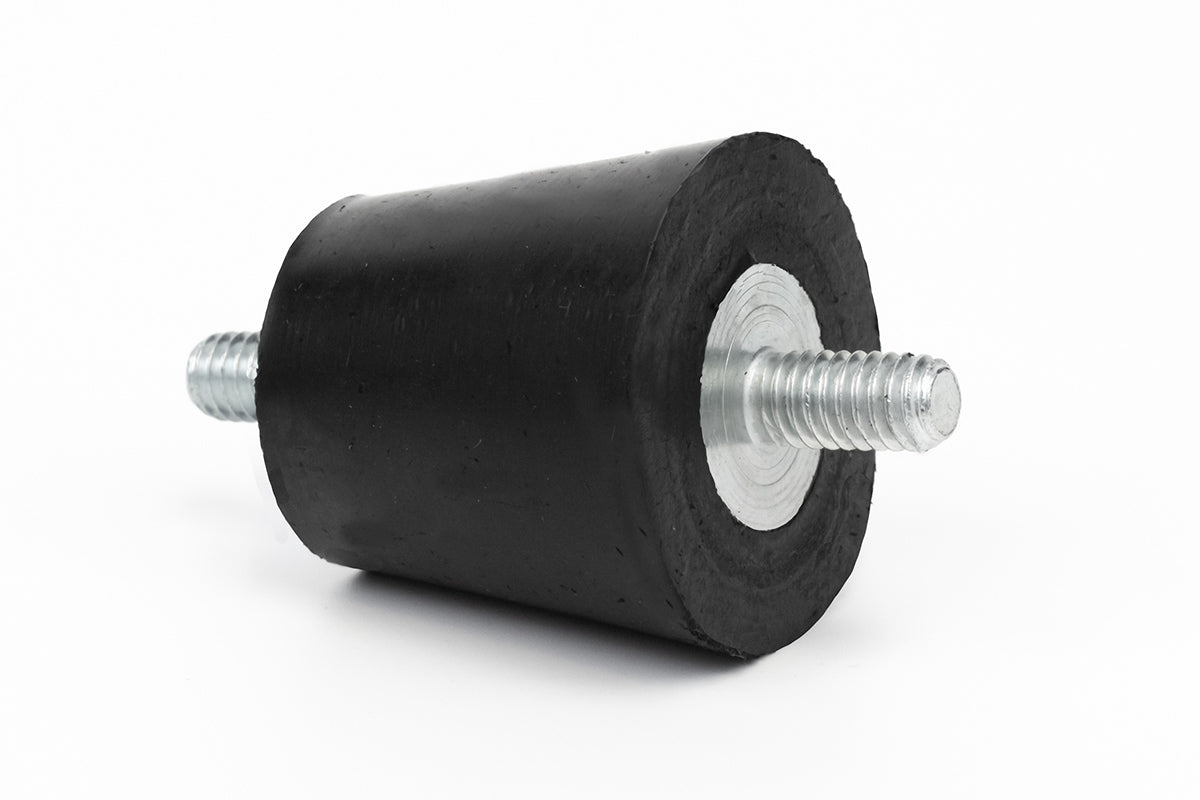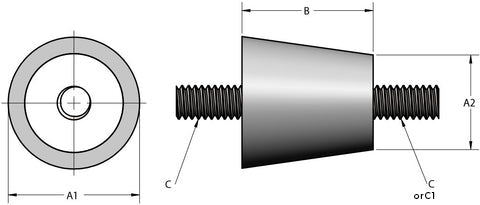

Tapered Vibration Isolation Mounts

The Tapered Vibration Isolation Male/Male is a common rubber mount typically used as a double studed, sandwich-style mount between two areas of vibration in mechanical and electrical applications. These male/male mounts can be a preferred configuration based on installation requirements and may be appropriate based on an uneven weight distribution from one side to the other. Tapered styles are sometimes preferred for stability and precision
- Tapered vibration isolation mounts are typically used as rubber mounts
- Typically used as anti-vibration isolation pads that require 2 male threaded inserts
- Applications by industry male/male both ends anti-vibration rubber mounts; industrial, aerospace, automotive, OEM, transportation, construction, healthcare, research, oil, and gas
- Sample product applications for Inventory# vibration isolation mount industrial vibration isolators, machine vibration isolation, HVAC, vacuum, engine, aerospace, motors, fans, medical equipment, and electronics
- Often referred to as anti-vibration isolation pads, rubber mounts, vibration isolation pads, anti-vibration rubber mounts, vibration isolation mounts, rubber isolation mounts, rubber vibration isolator, rubber engine mounts, spring vibration isolators, rubber motor mounts
What are Isolation Rubber Mounts?
Vibrations can cause a range of problems in machinery and equipment, from reduced performance to premature wear and tear. As such, it's crucial to take measures to minimize vibration and ensure smooth operation. One of the most effective solutions is the use of isolation rubber mounts. Isolation rubber mounts are specialized components designed to reduce the transmission of vibration from machinery to its surroundings.
They are made up of rubber or other elastomeric materials that can absorb and dampen the vibrations generated by equipment during operation. These mounts work by creating a barrier between the machinery and its base, preventing the transfer of energy that can cause noise, damage, and even safety hazards. Isolation rubber mounts come in different shapes and sizes, depending on the application and the weight of the equipment they need to support.
They are commonly used in industrial settings where heavy machinery is in use. The use of isolation rubber mounts is essential for ensuring smooth and safe operation of equipment while minimizing noise pollution and structural damage to buildings.
The Science Behind Vibration Control with Isolation Rubber Mounts
Isolation rubber mounts are an effective solution for reducing noise and vibration caused by machinery. They work by absorbing the energy that would otherwise be transmitted to the surrounding environment, creating a barrier between the machine and its surroundings. The science behind isolation rubber mounts is straightforward - they rely on properties such as mass, stiffness, and damping to control vibrations. When a machine operates, it creates forces that cause it to vibrate at certain frequencies. These vibrations can damage equipment or create unwanted noise if not controlled properly.
Isolation rubber mounts help to reduce these vibrations by providing a low-resonance path from the machine through which energy can dissipate safely into the surrounding structure. Rubber is an ideal material for this purpose due to its high elasticity and ability to absorb mechanical shock. It also provides resistance against chemicals and environmental factors making it durable in harsh conditions. Overall, isolation rubber mounts provide reliable protection against residual strain generated in machines subjected to dynamic loading while increasing their lifespan substantially.
Benefits of Using Isolation Rubber Mounts for Machinery
Isolation rubber mounts provide several benefits for machinery, including reducing noise and vibrations. By using anti-vibration mounts in your equipment, you can minimize the negative effects of vibration such as wear and tear, decreased accuracy, and increased maintenance costs. Using isolation rubber mounts also improves safety by reducing the risk of accidents caused by excessive movement or shaking. Additionally, it increases overall productivity since workers can focus better on their tasks when they don't have to deal with loud noises or distracting vibrations.
How to Choose the Right Type of Isolation Rubber Mount for Your Application
Understanding the Different Types of Isolation Rubber MountsThere are several types of isolation rubber mounts available in the market, and choosing the right one for your application is crucial. Load capacity and frequency range are two key factors that need to be considered when selecting isolation rubber mounts. The load capacity refers to the maximum weight an isolation mount can support without compromising its effectiveness. Frequency range indicates the vibrations' speed, which includes low-frequency vibrations such as those generated by heavy machinery or high-frequency ones like those produced by electronic equipment. By understanding these two parameters, you can identify which type of isolation rubber mount will work best for your specific needs and ensure effective vibration control for your machinery.
Factors to Consider When Choosing Isolation Rubber MountsWhen selecting isolation rubber mounts for your machinery, it's important to consider the weight and size of the equipment, as well as the frequency and amplitude of the vibrations it produces. Load capacity and resilience are key factors to keep in mind when choosing the right type of isolation rubber mount for your application. Additionally, you should consider the environmental conditions in which your equipment will be operating, such as temperature and exposure to chemicals or oils. By taking these factors into account, you can ensure that you select the most effective isolation rubber mounts for your specific needs.
Matching the Right Isolation Rubber Mounts to Your ApplicationChoosing the right isolation rubber mounts for your machinery is crucial in ensuring effective vibration control. One important factor to consider is the load capacity of the mount, which should be able to support the weight of your equipment. It's also important to consider environmental factors such as temperature and exposure to chemicals or oils, as these can affect the longevity of the mounts. Another key consideration is frequency range; different types of mounts are designed for specific frequency ranges depending on their application. Make sure you select a mount that matches with your machinery's operating frequencies. By matching the right isolation rubber mounts to your application, you can provide optimal protection against vibrations and extend equipment life span while minimizing maintenance costs.
Common Misconceptions About Vibration ControlCommon misconceptions about vibration control can lead to serious consequences for your machinery and business. One of the biggest misconceptions is that vibration is a minor issue that can be ignored. Vibration can cause significant damage to equipment, leading to costly repairs and downtime. Another misconception is that all isolation rubber mounts are the same. In fact, there are many different types of mounts designed for specific applications and choosing the wrong one can result in ineffective vibration control. Finally, some people believe that isolation rubber mounts are only necessary for large industrial equipment. However, even small machines can benefit from proper vibration control to improve performance and longevity.
In conclusion, isolation rubber mounts are essential for controlling vibration and preventing damage to machinery. By understanding the science behind these mounts and their benefits, as well as knowing how to choose and install them properly, you can improve equipment performance and prevent costly downtime. Real-life case studies demonstrate the effectiveness of isolation rubber mounts in various applications. Don't ignore the importance of vibration control - invest in quality isolation rubber mounts today to protect your machinery and improve your bottom line.
What Is Isolation Rubber?
What Is The Best Material To Stop Vibrations?
The best material to stop vibrations depends on the specific application and requirements. Different materials are used to dampen vibrations effectively, and the choice depends on factors like frequency, amplitude, and the environment. Common materials for vibration isolation include:
Natural Rubber: Natural rubber is versatile and widely used for its ability to dampen vibrations across a broad frequency range.
Neoprene: Neoprene rubber is resistant to oils and chemicals, making it useful in various industrial applications.


